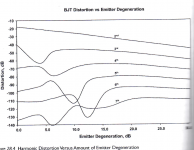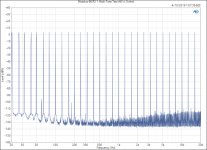That was linked 5 posts ago. You shouldn't only read the last post if you want to follow the thread 😉
Jan
Jan
Had a quick look at the generally accepted as best sounding high power, high end SS amps. By generally accepted i mean user opinions and can also add my own, with the exception of Robert Koda and Technical Brain which i have never heard.
Perhaps surprisingly, the majority of the best list employ no significant amount of loop FB, if any. The glaring exception being of course Boulder and imho this reflects strongly in their sound. I have not included any Pass Labs amps as those are well known here.
So, here is the list.
CH Precision.
User adjustable NFB, perhaps between 0 - 20db (the worst possible range according to a reformed former tube amp designer 😎)
Depending on NFB distortion varies between 0.1% - 0.01%
Dartzeel
Not sure if this qualifies as there is a substantial amount of nfb around the VA stage, but the output is not under the feedback loop.
D'Agostino
Advertised as low nfb. Not sure how low, but with an output impedance of 0.44ohm (Progression) and multiple output transistors it cannot be high
Gryphon
Only Antileon has "limited" nfb the rest have none.
Robert Koda K160
Zero loop feedback, yet surprisingly low distortion (0.005% at 50 watts into 8 ohm, 1KHz) and 160 Df
Technical Brain TBP-Zero EX
Zero loop feedback
Viola labs
low NFB...
Vitus Audio
Zero nfb at least in the Materpiece series
Perhaps surprisingly, the majority of the best list employ no significant amount of loop FB, if any. The glaring exception being of course Boulder and imho this reflects strongly in their sound. I have not included any Pass Labs amps as those are well known here.
So, here is the list.
CH Precision.
User adjustable NFB, perhaps between 0 - 20db (the worst possible range according to a reformed former tube amp designer 😎)
Depending on NFB distortion varies between 0.1% - 0.01%
Dartzeel
Not sure if this qualifies as there is a substantial amount of nfb around the VA stage, but the output is not under the feedback loop.
D'Agostino
Advertised as low nfb. Not sure how low, but with an output impedance of 0.44ohm (Progression) and multiple output transistors it cannot be high
Gryphon
Only Antileon has "limited" nfb the rest have none.
Robert Koda K160
Zero loop feedback, yet surprisingly low distortion (0.005% at 50 watts into 8 ohm, 1KHz) and 160 Df
Technical Brain TBP-Zero EX
Zero loop feedback
Viola labs
low NFB...
Vitus Audio
Zero nfb at least in the Materpiece series
Last edited:
When bringing into discussion 20...50kg worth of amplifiers against a 10kg good old days NAD or Kenwood you can imagine that the same value is in comparing how precise in a 10 000 dollar Rolex vs a 3 dollar electronic chinese watch...and it all depends on how good is the chinese watch battery...
So you cherry picked to troll the thread? Helpful.
What is the problem with that? Academics do this constantly to push their barrow.......
And what is the problem with identifying zero global feedback amps and linking them with the popular reviews? Are the reviews ALL incorrect?
This is largely the fb vs. non-fb amps, and some of the salient differences. It seems to me that there are very good amplifiers from both camps - and more the merrier.
THD remains a useful, technical figure but it is not the entire measure of excellence of an amp.
HD
Last edited:
I thought you’d missed the first one. Why did you post that facile Bob Cordell chart? 😉That was linked 5 posts ago. You shouldn't only read the last post if you want to follow the thread 😉
Jan
To show that the increase of distortion with feedback, if any, depends heavily on your starting point. I thought that was clear from the context.
The same chapter gives other examples, like the distortion of a single BJT stage as a function of emitter degeneration which of course is just local feedback.
So the phenomenon, that Cordell calls SGD (Spectral Growth Distortion) is not just a global feedback thing, it is a feedback thing per se.
The take-home for all this is clearly, you can't take any old crappy amp, slap some feedback on it and expect it to shine.
You need to start with something reasonable linear, and then feedback can improve it to any extend you want (or can keep stable).
I suspect that feedback's bad rap has a lot to do with crappy amps slapped by feedback.
Jan
The same chapter gives other examples, like the distortion of a single BJT stage as a function of emitter degeneration which of course is just local feedback.
So the phenomenon, that Cordell calls SGD (Spectral Growth Distortion) is not just a global feedback thing, it is a feedback thing per se.
The take-home for all this is clearly, you can't take any old crappy amp, slap some feedback on it and expect it to shine.
You need to start with something reasonable linear, and then feedback can improve it to any extend you want (or can keep stable).
I suspect that feedback's bad rap has a lot to do with crappy amps slapped by feedback.
Jan
Attachments
Last edited:
And what is the problem with identifying zero global feedback amps and linking them with the popular reviews? Are the reviews ALL incorrect?
When amplifiers with class D output stages with 100dB of NFB are getting into class A then you could argue that either
a) it doesn't matter if its implemented properly
b) high end audio is total BS anyway and the reviewers go on how shiny it is.
or
c) Audio isn't actually that hard so anything will sell with a good marketing story.
Given some of the measurements I see on highly rated amplifiers I am tempted to say that b) may be worringly close to the truth.
THD remains a useful, technical figure but it is not the entire measure of excellence of an amp.
HD
I think its outdated and those who won't do a multi-tone test are hiding behind an old measurement.
Last edited:
Perhaps, but HD and IMD are results of the same non-linearities. I think it's just trendy amongst some designers to knock the value of THD
Yes, you are right. The induced EMF always opposes the driving EMF: Lenz's Law.Induced EMF is effectively in series, not parallel, otherwise it couldn't have an effect on the current in a voltage-driven coil.
I think it's just trendy amongst some designers to knock the value of THD
Purely personally I think the attached (courtesy of TomChr) tells you a lot more about what goes on with complex music signals than a THD+N plot where THD is below the noise floor a lot of the time. Analysing these sort of plots between topologies would be most interesting if people actually did them regularly. But my opinion only.
Attachments
I suspect that feedback's bad rap has a lot to do with crappy amps slapped by feedback.
Jan
I think it's true, and interesting part is, people compared their crappy amps slapped by feedback with their crappy amps without it, they felt crappy amp is better for some reasons. 🙂
Since THD can be extremely low without high gnfb, what else does high gnfb offer in performance improvement?
B1B
Depending, but often ruler-flat frequency response and/or bandwidth extension, almost-zero output impedance, suppression of supply ripple and noise, that sort of thing.
Jan
jan.didden, thank you for the examples and confirming what I said. It depends on the linearity of the design before adding gnfb.
I think that's why Putzeys deliberately chose a theoretical worst-case example with very high 2nd order harmonics as the starting point.
I think that's why Putzeys deliberately chose a theoretical worst-case example with very high 2nd order harmonics as the starting point.
I tend to agree with Hugh. I say there is a difficulty with equating sound quality and THD. If there were no other parameters at play then this would be sensible.
Just to be controversial, I think Bruno is somewhat full of it. It’s not like he invented the Bessel filter. He is using really old technology to push up his in-band THD figure. That’s been an option for over a century, although not digitally implementable. What could be better for THD marketing? Class D is a power for price/cost solution. It’s not an audiophile solution. The fidelity problems of class D go way beyond THD and this illustrates how superficial THD is as a measure.
Just to be controversial, I think Bruno is somewhat full of it. It’s not like he invented the Bessel filter. He is using really old technology to push up his in-band THD figure. That’s been an option for over a century, although not digitally implementable. What could be better for THD marketing? Class D is a power for price/cost solution. It’s not an audiophile solution. The fidelity problems of class D go way beyond THD and this illustrates how superficial THD is as a measure.
If class D is not an audiophile solution explain how there are stereophile Class A amplifiers with hypex modules in?
I’m not sure what you are referring to, Bill.
Don’t you think the idea of a “class A class D amplifier” is a little odd?
Don’t you think the idea of a “class A class D amplifier” is a little odd?
- Home
- Amplifiers
- Solid State
- Global Feedback - A huge benefit for audio

